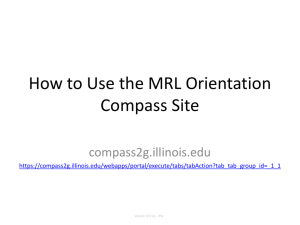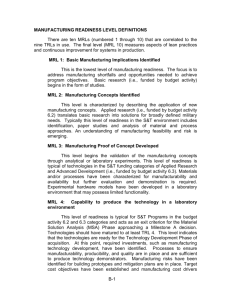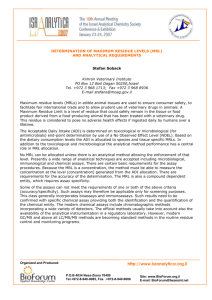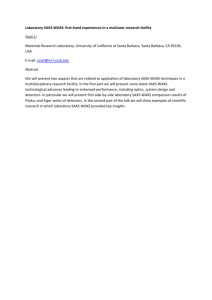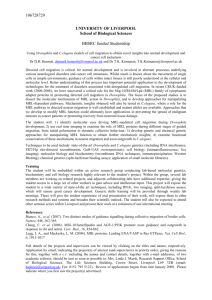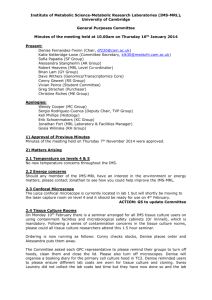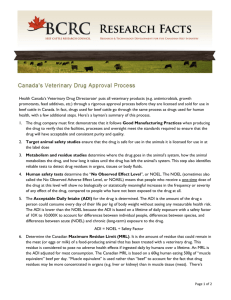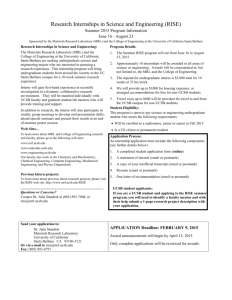Propose Updates to Handbook - Manufacturing Readiness Levels
advertisement
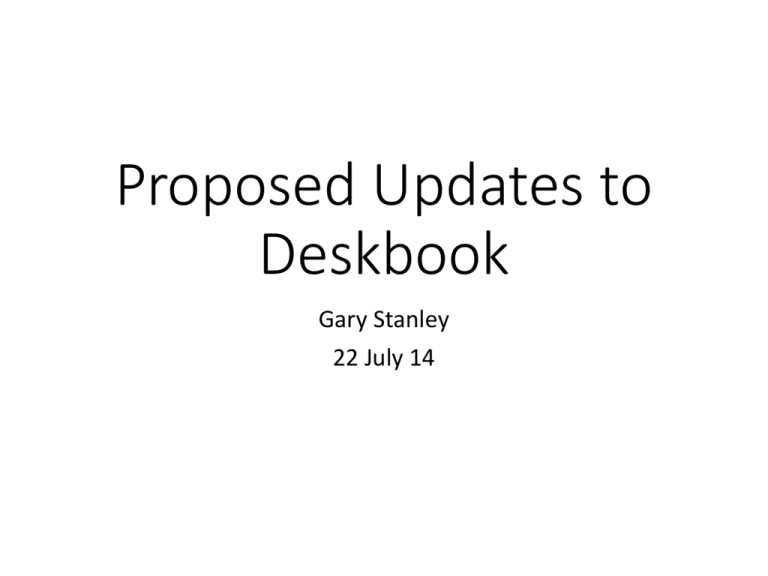
Proposed Updates to Deskbook Gary Stanley 22 July 14 Changes • Due to new DoDI 5000.02 • Terminology Changes • Requirement Changes • Proposed Changes to Matrix due to customer Feedback • Proposed Changes to Deskbook due to customer Feedback • Proposed Addition to Deskbook to incorporate Users Guide into the process • Proposed Addition to Deskbook Appendix to perform MRL assessments of non-acquisition programs • Will be addressed in Session 2 today and tomorrow 2 Due to new DoDI 5000.02 Terminology Changes • • • • Replace TD with TMRR Replace TDS with AS Update Deskbook, Matrix, and Acronyms list Update Figure 3.1 to New Terminology 3 Due to new DoDI 5000.02 – Requirement Changes • Requires a New Paragraph 1.1. • Proposed new paragraph Department of Defense Instruction (DoDI) 5000.02 continues to reinforce the requirement to address manufacturing over the entire life cycle. Provided are some of the new requirements. It now requires the Program Manager (PM) to ensure manufacturing risk is addressed throughout the program’s lifecycle . Beginning in the Materiel Solution Analysis (MSA) Phase, policy requires that manufacturing readiness and risk be assessed and documented in the System Engineering Plan (SEP).(1) By the end of the Technology Maturation Risk Reduction (TMRR) Phase: • Prototypes will be included in this phase if they will materially reduce engineering and manufacturing development risk.(1) • Before leaving this phase all sources of manufacturing risk have been adequately mitigated to support production.(1) • Manufacturing processes will be assessed and demonstrated to the extent needed to verify risk have been reduced to an acceptable level. 4 Due to new DoDI 5000.02 – Requirement Changes (con’t) During the Engineering and Manufacturing Development (EMD) Phase, PMs will assess the maturity of critical manufacturing processes to ensure they are affordable and executable. Prior to a production decision, the PM will ensure manufacturing and producibility risks are acceptable, supplier qualifications are completed, and any applicable manufacturing processes are or will be under statistical process control.(1) The new DoDI states that the Low Rate Initial Production (LRIP) line provides an efficient ramp up to Full Rate Production (FRP).(1) In addition to the new emphasis placed on manufacturing by DoDI 5000.02 there has been additional focus placed on manufacturing by both Congress and the GAO. Specifically, Congress has put the focus of managing manufacturing risk as a new “Public Law”(2). The GAO(3) found that DOD faces problems in manufacturing weapon systems—systems cost far more and take much longer to build than estimated. Billions of dollars in cost growth occur as programs transition from development to production, and unit-cost increases are common after production begins. Contributing factors to these problems include: inattention to manufacturing during planning and design, poor supplier management, and a deficit in manufacturing knowledge among the acquisition workforce. 5 Due to new DoDI 5000.02 – Requirement Changes (con’t) Essentially, programs did not identify and resolve manufacturing risks early in development, but carried risks into production where they emerged as significant problems. They have recommended that DoD adopt the use of MRLs to help manage the manufacturing risk. The Defense Acquisition Guide(4) Chapter 4 states that assessment of manufacturing risks is a best practice and refers to this guide to accomplish this requirement. References; 1) DoDI 5000.02, 25 Nov 2013 2) P.L. 112-81, 31 Dec 2011: SEC 834 3) GAO 10-439, Apr 2010 4) DAG Chapter 4, Systems Engineering 6 Proposed Changes to Matrix – Due to Customer Feedback • Change TRLs for MRL 8 and 9 • MRL 8 • Was – Should be assessed at TRL 7 • Proposed – Should be assessed at TRL 7 or 8 • MRL 9 • Was – Should be assessed at TRL 9 • Proposed – Should be assessed at TRL 8 or 9 • Eliminate DFx and replace with Design for Manufacturing and Design for Assembly – Now consistent with new AS6500 • Was – Producibility enhancement efforts (e.g. DFX) ongoing for optimized integrated system. • Proposed – Producibility enhancement efforts (e.g. Design for Manufacturing and Design for Assembly) ongoing for optimized integrated system. 7 Proposed Changes to the Deskbook – Due to Customer Feedback • Recommendation by User • Develop Definition for “Production Line” • Eliminate the term “Environment” in our definitions • Update the Deskbook to reflect these changes • This is targeted to help eliminate some confusion with these terms 8 Proposed Changes to the Deskbook – Due to Customer Feedback (con’t) • Definition of Production Line Production Line – An environment that incorporates all verified capabilities required to manufacture production configuration items, subsystems, or systems that meet design requirements utilizing manufacturing processes and procedures that are under control (i.e., PPVs and FAIs/FATs have been satisfactorily completed). 9 Proposed Changes to the Deskbook – Due to Customer Feedback (con’t) • Eliminate the term “Environment” in our definitions Production relevant environment—An environment with some shop floor production realism present (such as facilities, personnel, tooling, processes, materials etc.). There should be minimum reliance on laboratory resources during this phase. Demonstration in a production relevant environment implies that contractor(s) must demonstrate their ability to meet the cost, schedule, and performance requirements of the EMD Phase based on their production of prototypes. The demonstration must provide the program with confidence that these targets will be achieved, but does not require a production line. Furthermore, there must be an indication of how the contractor(s) intends to achieve the requirements in a production representative and pilot environments and on a pilot line. 10 Proposed Changes to the Deskbook – Due to Customer Feedback (con’t) • Production representative environment—An environment that has as much production realism as possible, considering the maturity of the design. Production personnel, equipment, processes, and materials that will be present on the pilot line should be used whenever possible. The work instructions and tooling should be of high quality, and the only changes anticipated on these items are associated with design changes downstream that address performance or production rate issues. There should be no reliance on a laboratory environment or personnel. 11 Proposed Changes to the Deskbook – Due to Customer Feedback (con’t) • Pilot line environment—An environment that incorporates all of the key production realism elements (equipment, personnel skill levels, facilities, materials, components, work instructions, processes, tooling, temperature, cleanliness, lighting etc.) required to manufacture production configuration items, subsystems or systems that meet design requirements in low rate production. To the maximum extent practical, the pilot line should utilize full rate production processes. 12 Proposed Changes to the Deskbook – Due to Customer Feedback (con’t) • Update the Deskbook to reflect these proposed changes Examples; 1.2.1 MANUFACTURING-RELATED SUCCESS CRITERIA ESTABLISHED FOR TECHNOLOGY DEVELOPMENT AND ACQUISITION STRATEGIES . . . The AS is a comprehensive, integrated plan . . . Similarly, the results of the demonstrations of manufacturing processes in on a pilot line environment that are reflected as success criteria for the Production Readiness Review (PRR) . . . MRL 8: Pilot line capability demonstrated; Ready to begin Low Rate Initial Production . . . Manufacturing and quality processes and procedures have been proven in on a pilot line environment and are under control and ready for low rate production. Known producibility . . . 13 Proposed Changes to the Deskbook – Due to Customer Feedback (con’t) 2.4 DEFINITION OF TERMS . . . Pilot line environment — An environment that incorporates . .. . . . The definitions of production relevant, production representative, and pilot line environments are intended to demonstrate the natural progression of manufacturing maturity ... 4.2 . . . If the assessment is being conducted on a pilot production line, emphasis will be placed on understanding what the desired production capability and capacity is to meet program objectives in cost, schedule (e.g., low rate production rates) and performance and to anticipate whether there will be any problem with full rate production processes. The nominal MRL target would be 8 as an entrance criterion for Milestone C. 14 Proposed Addition to incorporate User Guide into the process 7 Tools for Performing Assessments of Manufacturing Risk and Readiness 7.1 The MRL Users Guide The MsExcel-based MRL Users Guide was developed to supplement the MRL Deskbook and provide the user with most of the information needed to perform an MRA at any stage of the acquisition or product development lifecycle. The Users Guide consists of six worksheets: 1. The first worksheet contains instructions on how to operate the Guide. 2. The second worksheet is the digital Users Guide that has the capability to display detailed information about the MRL or Product Life Cycle simply by clicking on a given cell or icon for which information is desired. The cells down Column A provide information about the specific threads that are traced in that row of the matrix. The cells and icons in Rows 2 through 6 display information about the phases of the Product Life Cycle, Acquisition Reviews, Acquisition Milestone descriptions, MRL and TRL definitions and background information for that stage of the product life-cycle. 3. The third worksheet is a list of Definitions for terms typically used in the acquisition and manufacturing readiness assessment process. 15 Proposed Addition to incorporate User Guide into the process (con’t) 4. The fourth worksheet is a List of Acronyms commonly used in manufacturing and in the development and acquisition process. 5. The fifth worksheet contains a Printable MRL Matrix for those who wish to view or print the entire matrix on a single sheet. 6. The sixth worksheet contains a complete list of questions (criteria), derived from the MRL Matrix, to be used in assessments of manufacturing readiness. This Questionnaire is intended to be tailored to the system, subsystem, or component being assessed and be limited to questions focused on the target MRL or one level lower. The user may make a copy of the questionnaire which can then be sorted and tailored to select appropriate questions for the item and MRL targeted in the assessment. 7.1.1 Description of the “Mega-Data Sheet” When specific cells in the main body of the MRL Matrix are selected, they will display a "Mega-Data Sheet" with the following information: First, the Thread designation (A1, B2, etc.) and MRL number (1 through 10) will appear at the top. The associated text (criteria) of the cell from the MRL Matrix will appear in the next block for reference to let the user know which cell is being viewed. The main body of the Data Sheet will contain the following information: 16 Proposed Addition to incorporate User Guide into the process (con’t) • Purpose: The intent for doing the assessment for this particular sub-thread at this point in the life-cycle and the reason for doing the assessment of this particular thread at this point, i.e., what requirements/documents/procedures drive the assessment? • Sources of Information: This is where data can be collected for a particular MRL Assessment at that stage of the product life-cycle. • Questions (sometimes called "criteria"): These are directly derived from the text of the MRL Matrix from the latest revised Version 11.3 of the MRL Questionnaire. • Additional Considerations: Sometimes from past experience, services or industry have optional questions they may want to ask for specific threads or sub-threads at specific times in the life-cycle. If so, these will be included in the mega-data sheet. This part of the Users Guide may change significantly over time. • Lessons Learned: These are particular lessons derived from past experience of personnel doing risk assessments in this particular sub-thread at this specific point in the product life-cycle. These may also change as people gain more experience doing assessments of manufacturing risk and readiness. 7.1.2 Compatibility The MRL Users Guide version 13 and higher is compatible for use with MsExcel versions 2010 and 2013 using a standard Windows 7 or 8 Operating System. 17 Proposed Addition a New Appendix • MRL Assessments of non-acquisition programs 7.2 Capability Manufacturing Readiness Level (CMRL) Questionnaire A new set of criteria has been established to assess the level of risk and readiness of developing a capability and/or commodities (reference “Appendix C”). These “Capability Manufacturing Readiness Levels,” or CMRLs, adopt most of the same structure and definitions used for MRLs with some terminology changes but are independent of the DOD acquisition time-dependent life-cycle. The criteria or questions to be asked in determining the CMRL of a developmental item or product are categorized by same nine threads and 22 subthreads as MRLs, and CMRLs use the same scale from One (the most basic level) to Ten (the most advanced state of readiness). Terms specific to acquisition programs such as milestones and program phases have been modified or deleted, but the progression from immature capability to advanced is preserved. Specific reference to DOD design reviews has also been eliminated, though there remains a need for rigorous design analysis and reviews applicable to the production of the material or commodity being analyzed. As with the standard MRL Questionnaire, this questionnaire is intended to be tailored to the capability or commodity being assessed and to be limited to questions focused on the target MRL or one level lower. 18 Summary • Only the changes that are required are the ones due to the New DoDI 5000.02 • Update to the New Terminology • Changes to paragraph 1.1 • Need you feedback on all proposed changes plus others you might have • Will review the new Appendix language in second session this afternoon 19
